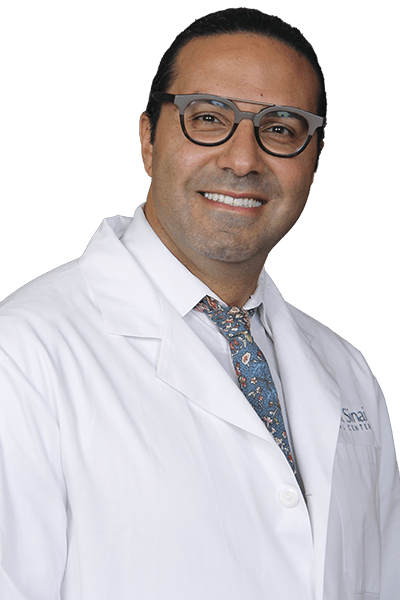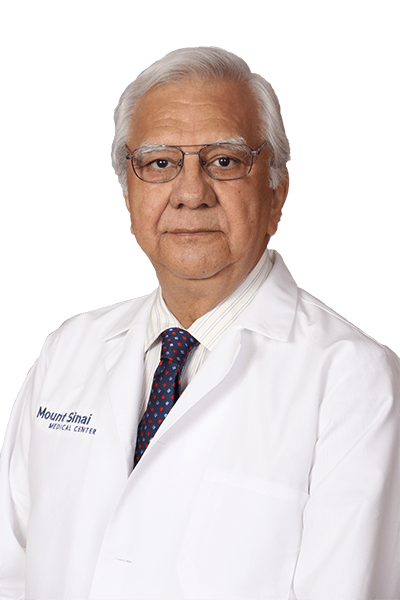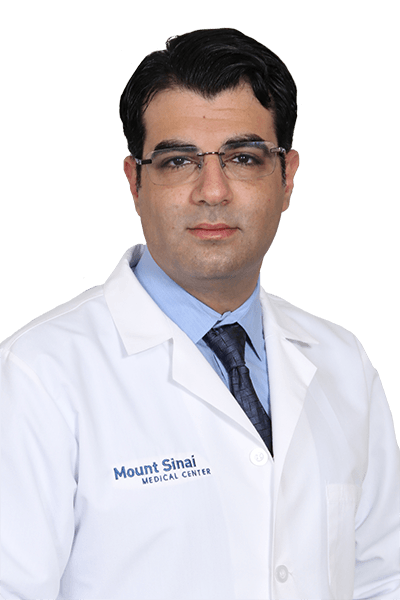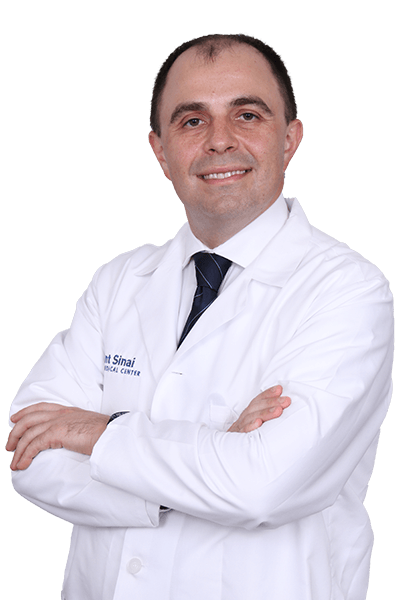Endovascular Surgery
The goal of our vascular intervention at Mount Sinai Medical Center is to widen or open any narrowed or closed-off blood vessels. This means that oxygenated blood can reach the tissue and organs affected by the disease, preventing further organ damage. We also aim to alleviate symptoms.
The physicians, technologists, and other providers on Mount Sinai’s team utilize the following treatments for vascular-related conditions:
Aortic Disease
- Aortic Dissection Repair – There are two possible surgery methods for aortic dissection repair. The first is standard open-heart surgery. The second is less invasive endovascular surgery. After the incision, you will be placed on a heart bypass machine to take over pumping blood around your heart and lungs. After the surgeon finds the tear in the vessel, synthetic grafts replace the damaged area and the vessel is sealed.
- Custom-Made Graft Endovascular Aortic Repair – In complex cases, we can make a customized graft. They are altered by creating fenestrations (holes) that allow additional stents, or rigid tubes, to be inserted into the blood vessels that supply blood to these critical organs.
- Endovascular Thoracic and Abdominal Aneurysm Repair – This approach is often the approach of choice for high-risk patients. This procedure uses long, thin tubes called catheters to deliver a stent-graft, or fabric tube supported by metal mesh, to where the aneurysm is located.
- Open Aortic Aneurysm Repair – This is a major surgery that starts with clamps on the aorta above and below an aneurysm, a bulge in the wall of an artery. This stops blood flow through the area so the surgeon can remove the aneurysm and attach the graft to the aorta. Sometimes, the doctor leaves the aneurysm wall intact, and the graft is placed inside the aneurysm. After the aorta is repaired, the doctor removes the clamps so that blood can flow through the aorta again.
Arterial Disease
- Angiography with Atherectomy, Angioplasty, or Stenting – Angiography is a method to identify the location of the blockage in a vessel by using a contrast material that shows up on an X-ray. At that time, a balloon angioplasty can be performed. It is also called a percutaneous transluminal angioplasty (PTA), and involves the use of a thin tube (catheter) that is inserted into a blocked or narrowed artery. The catheter has a tiny balloon on its tip that is inflated to push the plaque against the artery’s walls to widen the path for blood flow. Atherectomy manually removes the clot from the vessel or a stent can be placed to allow adequate blood flow by pushing the plaque against the wall.
- Multidisciplinary Critical Limb Salvage Program – The team at Mount Sinai Medical Center includes vascular specialists, podiatrists, and wound care surgeons, and involves various treatments to save a limb.
Carotid Disease
- Transcarotid Artery Revascularization (TCAR) – This is a minimally invasive treatment for patients who have blockages in the neck arteries (carotid arteries) and are at a risk of stroke. The TCAR procedure temporarily reverses blood flow in the artery while the surgeon places a stent, or rigid tube, in the artery. This minimizes the risk of stroke.
Dialysis Access
- AV Fistula – This is a surgically created connection between the artery and the vein. It is the preferred method and can resist clotting and infection.
- AV Graft – This is a small tube that serves as an indirect connection between an artery and a vein via a plastic tube or possibly an artery from an organ donation.
- Endovascular Maintenance of Dialysis Access – Pseudoaneurysm (PSA) formation is a complication of hemodialysis access. Open repair requires a resection; placement of the graft, or tube; and the insertion of a catheter, or a long, thin tube, as a bridge. Endovascular stent graft repair is an alternative that permits immediate use of the access site for hemodialysis.
- Open & Endovascular Access Creation – This refers to a longer incision, which is made so the vessels can be seen externally. This is done instead of placing a stent, or rigid tube, inside the vessel.
Mesenteric and Renal Disease
- Celiac and Superior Mesenteric Artery Stenting – This is performed by accessing blood vessels via an incision in the groin to place the stent in the blocked vessel.
- Renal Artery Stenting – This is similar to the placement of any stent, or rigid tube, using the renal artery as a destination.
- Visceral Aneurysm Stent Grafting or Embolization – This procedure involves the placement of an embolic solution, which has particles suspended in a solution, to create a filling of the aneurysms, which are a bulge in the wall of the artery. There are multiple variations of this procedure.
Peripheral Artery Disease (PAD)
Treatment for PAD involves controlling symptoms and slowing progression of the disease. Smoking cessation, exercise, and medication can help slow the progression of PAD, and in some cases, may even reverse it. If lifestyle changes aren’t enough, the physician may recommend an angioplasty, a minimally invasive procedure to widen blocked or narrowed blood vessels. In some cases, a stent (tiny wire cage with or without medication) may be placed within the blood vessels to keep them open after the procedure. In the most severe cases of PAD, bypass surgery is used to redirect blood flow around damaged vessels.
Varicose Veins
Treatment of varicose veins focuses on easing symptoms and improving circulation to prevent the condition from getting worse. Many symptoms can be controlled by wearing compression stockings, elevating the legs, exercising, and avoiding long periods of sitting or standing. If lifestyle changes aren’t enough, there are several minimally invasive, outpatient procedures to close or remove varicose veins.
- Laser Ablation of Varicose Veins – This treatment is a popular choice for people due to its outpatient nature, less pain, and less scarring. Also called endovenous (within the vein) laser treatment or ablation, it is performed by passing a laser fiber from the knee to the groin and then delivering laser energy to the entire inside of the vein. Destruction of the vascular wall is followed by fibrosis (scarring or closing off the vein). It has been shown to yield excellent long-term (>5 years) results and a low rate of complications, which vary with the laser wavelength used.
- Phlebectomy – This is a minimally invasive surgical procedure in which veins are punctured, collapsed, and removed through tiny incisions while the patient is under local anesthesia. Varicose veins can also be tied off and/or surgically removed while the patient is under general anesthesia.
- Sclerotherapy – This is the preferred method for treating smaller veins. It involves injecting veins with a solution that causes them to shrink until they are reabsorbed into the body. Lasers can also be used to close diseased veins.
Our Physicians
Micheal T Ayad, MD
Chief, Division of Vascular Surgery
Director, Vascular Institute
Co-Director, Aortic Center
- Endovascular Surgery
- Vascular Surgery
- Aortic Aneurysm Repair
- Mount Sinai Medical Center (Main Campus)
- 305.674.2071
- Mount Sinai Emergency Center, Physician Offices, Cancer Center and Diagnostic Center Aventura
- 305.692.1072
- Mount Sinai Specialty Care Key West I Cardiology, Urology & Vascular Care
- 786.584.5555
Manuel Sivina, MD
- General Surgery
- Vascular Surgery
- Mount Sinai Medical Center (Main Campus)
- 305.674.2121
Edward Andraos, MD
- Vascular Surgery
- Aortic Aneurysm Repair
- Mount Sinai Medical Center (Main Campus)
- 305.674.2071
- Mount Sinai Emergency Center and Primary & Specialty Care Hialeah
- 786.584.5555
- Mount Sinai Specialty Care Key West I Cardiology, Urology & Vascular Care
- 305.294.8334
Jacob Schwartzman MD, MPH
- Vascular Surgery
- Mount Sinai Medical Center (Main Campus)
- 305.674.2906
- Mount Sinai Emergency Center, Physician Offices, Cancer Center and Diagnostic Center Aventura
- 305.692.1072
- Mount Sinai Specialty Care Key West I Cardiology, Urology & Vascular Care
- 305.294.8334
Stephen W Unger, MD
- General Surgery
- Vascular Surgery
- Mount Sinai Medical Center (Main Campus)
- 305.674.2121






